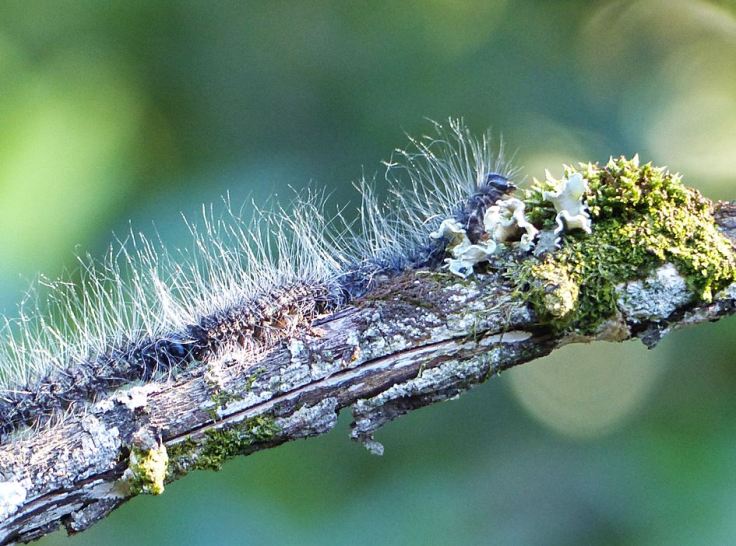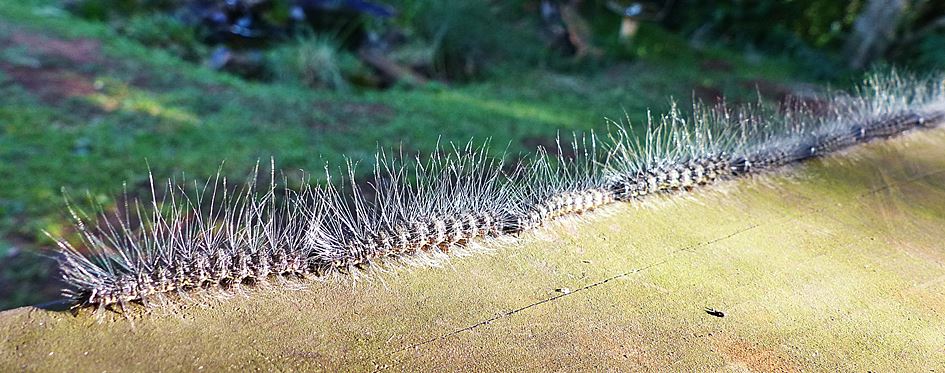Each autumn, dozens of hairy caterpillars congregate on the Cross-berry trees in our garden. These caterpillars are the larvae of the moth named Reticulate Bagnet (Anaphe reticulata). They become conspicuous not only because they congregate in groups on tree trunks and even on plant pots, but they are also noticeable for following each other head to tail in long single-file trails, hence the collective name for this type of caterpillar: processionary caterpillar.

There are several species of processionary caterpillars in the world, all of them hairy. Fortunately, the species we have in South Africa, including Anaphe reticulata, do not have the same level of toxicity in their hairs as some species do, and so even in large groups they do not present as a health hazard, although it is best not to touch these hairy critters. Our dogs instinctively, or so it appears, leave these caterpillars alone, even when they form a long procession along the ground.
In an article on processional caterpillars in the online Natural History magazine, Terrence D. Fitzgerald, a biologist who studies the behavioural and chemical ecology of social caterpillars, explains that although each caterpillar leaves a small trail of silk and a trail of pheromones as they move along in their single-file processions, they are also able to “march in line” by keeping in touch through contact with the caterpillar ahead: quite literally they follow the leader. Fitzgerald concludes that the silk trail provides traction for their feet and the pheromone trail makes it easier for them to follow the route and to assist latecomers, so making trail-following more efficient.

The caterpillars’ final trail, after their last meal, is to find a place where they can spin their silk purse-like communal cocoon (their bagnet) where they pupate to emerge as moths in the spring. In their book Field Guide to Insects in South Africa, Mike Picker, Charles Griffiths and Alan Veaving note that some of these bagnets can contain up to 600 cocoons. The small-to-medium-sized moths that emerge are creamy-white with a network of brown markings on their wings.
Textiles from the wild silk of various caterpillar species, including several Anaphe species, have been made in many countries in Africa for centuries. Yoruba and Hausa textiles in West Africa are particularly well known. In the case of the Anaphe species, the silk bagnets are harvested after the moths have left. The bagnets are processed and the fibres are spun into yarn to be woven into textiles.

On the website africanmoths.com, it is noted that the Reticulate Bagnet occurs in Angola, DRCongo, Eritrea, Ghana, Ivory Coast, Malawi, Mozambique, South Africa, Tanzania, Togo, Zambia and Zimbabwe, and it lists a total of nine larval food plants that host this species. Included in the list is the Cross-berry (Grewia occidentalis), the plant favoured by the caterpillars in our garden. Interestingly, even though we have another host plant, Dombeya rotundifolia (Wild Pear), in the garden, we have only noticed the caterpillars feeding and sheltering on the Cross-berry. ★
Posted by Carol at letting nature back in








October 24, 2018 at 6:41 am
Owner of a yorkie is having to put their dog down today. She was rushed to the vet a few days ago when found frothing at mouth & vomiting. Vet found hair in mouth & throat, also pulled out segments of the caterpillar out of her throat. What caterpillar here in KZN near Eston is toxic to dogs?
LikeLike
October 24, 2018 at 7:39 am
I am so sorry about this sad situation and I really feel for the owner of the Yorkie. I would expect that any hairy caterpillar would be dangerous if eaten. Even if the spines or hairs are not overtly toxic an extreme allergic reaction is possible for the unfortunate animal eating such a caterpillar. For more information about caterpillars in the region you could contact an entomologist either at UKZN or at the KwaZulu-Natal Museum, both in Pietermaritzburg. I add that Processionary Caterpillers specifically are unlikely to have hatched yet in KZN, as usually this takes place later in the season. Please convey my sympathy to the owner of the little dog.
LikeLike
February 6, 2017 at 8:00 am
I recall reading somewhere that the processionary caterpillars in Spain have a dangerous toxicity, which, fortunately for us, the species here don’t have.
LikeLike
February 6, 2017 at 7:40 am
We don’t see these in England, but they were a big feature of spring time life when we lived in the foothills of the Pyrenees. They wove their extraordinary hairy cocoons in fir trees. and dog owners had to be vigilant against their pets nuzzling them and perhaps asphyxiating. Yours don’t look quite the same.
LikeLike